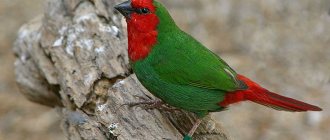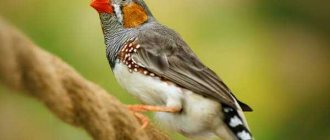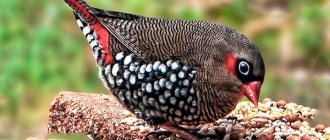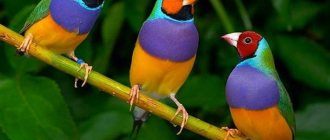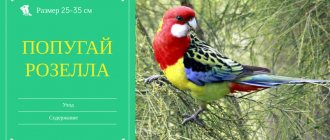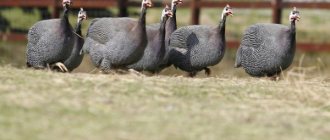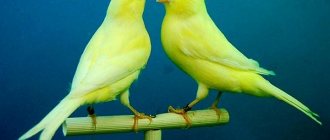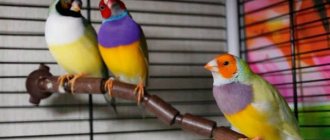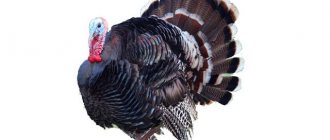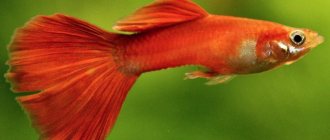Amadina Gulda is a small bird from the family of finch weavers. It lives in the wild in Australia. It is kept at home by hobbyists all over the world.
This species was discovered by the British scientist John Gould. He made a description of it in 1844. After this, the importation of Gould's finch began to European countries, where it quickly gained popularity among home collectors.
Appearance
Amadina Gulda is small in size: the body length of an adult bird reaches 11 cm, including the tail - 15 cm. Sexual dimorphism is not pronounced.
The plumage is bright: the back and wings are green, the tail and neck are blue, the breast is purple, the belly is yellow. The head can be colored red, black or yellow-orange. Breeders have developed many morphs of Gould's finches, the color of which is very different from the natural one.
Gould's finches and people
Small beautiful birds can be raised as pets. But their maintenance is not easy; beginners will have to try a little to ensure proper conditions. There are pros and cons to keeping Gould's finches.
Positive:
- they do not require much attention from people;
- are not distinguished by loud singing;
- they look very bright and cute.
Negative:
- require special conditions of humidity and temperature;
- suffer from diseases;
- need space and cleanliness.
Habitat
The Gouldian finch lives in the tropical forests of Northern Australia and leads a nomadic lifestyle, migrating inland and to the coastline depending on weather conditions and the availability of food supply. Birds live in flocks of up to several tens of thousands of individuals. During the breeding season, finches stay in the savannahs of the Kimberley District, where the air temperature in the shade reaches 40-45°C. Air humidity remains at 80-90%.
Interesting fact! The species was described by naturalist John Gould in the mid-19th century. The researcher named the bird he discovered “Lady Gould's finch” in memory of his wife.
What a wonderful creature
Finches belong to the family of weaver finches (songbirds from the order Passeriformes, which got their name due to the ability to make nests from flexible blades of grass, separating fibers along the entire length of the leaf and moistening them with saliva), representatives of which can be seen anywhere on our planet.
As for finches, in nature they live mainly in Africa and Australia, some species can be seen in South Asia - at the same time they live both in open areas and feel good in dense thickets on the outskirts of forests.
Finches look like this:
- This bird is cheerful, extremely active and very trusting;
- Its dimensions are small - the length of the body is from 10 to 15 cm;
- Although they are classified as songbirds, they sing poorly: they can, of course, produce a melodic trill, but it resembles not so much singing as whistling, chirping, buzzing, grumbling or hissing. Males sing much better than females.
- The beak of finches is thick, arched along the ridge and looks translucent, thereby creating the impression that it is made of wax (they are even sometimes called wax beaks). The claw of adult males is a rich coral color, that of females is orange, and that of young birds is black;
- The plumage is dense, motley and extremely beautiful, often numbering five or more shades.
Conditions of detention
The content of Gould's finch has its own nuances and may seem difficult for a beginner. This species is quite gentle and does not forgive the owner for gross mistakes.
Cage and accessories
Gouldian finches do not tolerate crowded conditions. The size of the cage should allow birds to fly freely around it. The minimum dimensions of a home for a pair of individuals (LxWxH) are 60x40x50 cm with a distance between the rods of no more than 1 cm. The species needs a certain temperature and humidity regime, which is more convenient to maintain in a box-type cage made of plywood or other solid material, closed with a lattice only on the front side .
All accessories required by the bird must be placed in the cage:
- Perches. They are made from linden, aspen or willow branches with a diameter of about 10 mm. It is important that they do not sway or move under the weight of the bird, and that the finch sitting on them does not touch the bars with its tail.
- Feeders. They are installed at the bottom of the cage or hung from the wall. It is necessary to ensure that one always contains food, and the other is used for mineral feeding.
- Drinking bowl. It is placed at the bottom of the cage and filled with settled or filtered water.
- Bathing suit. For bathing finches, baths slightly larger than the bird’s body are suitable. A layer of water 1.5 cm high is poured into them and placed on the bottom of the cage or attached to the wall.
Diet
To maintain health, Amadina Gulda must receive a balanced diet containing all the nutrients the bird needs. The basis of the diet is grain mixtures. Sprouted grains are extremely beneficial. The birds are also fed vegetables (bell peppers, grated carrots), sweet fruits and berries, insects, boiled eggs, gammarus, cottage cheese, lettuce, dandelion, plantain, shepherd's purse and other herbs. In winter, they give dried greens. Crushed eggshells or chalk are used as a source of calcium. You can add purchased vitamin and mineral supplements to your diet. Ready-made mixtures for exotic birds are also suitable for finches.
Attention! To properly carry out the digestion process, birds need fine gravel or coarse sand. It is placed inside the cage and is freely accessible.
Care
Air temperature is very important for Gould's finches. It should not fall below 22-24°C. Air humidity should be maintained at 50-55%. Birds of this species do not tolerate drafts and sudden changes in temperature. The cage should not be placed near heating appliances.
Daylight hours for this species must be at least 10-12 hours, so in winter it is necessary to use fluorescent lamps. Finches do not like flickering light, as well as sudden switching on and off of lamps in the dark, so the lighting source should be equipped with a dimmer.
Finches cannot tolerate noise or sharp sounds. You should not place a TV in the room where the bird cage is located. You should not talk or shout loudly in the presence of finches. Gouldian finches often bathe to maintain their plumage. The water in the bathtub is changed daily by rinsing the container with hot water.
The cage is cleaned regularly. If the floor is covered with bedding (river sand, sawdust or purchased filler), cleaning is done 1-2 times a week. If there is no litter, the cage should be cleaned daily. In this case, the floor, perches and other elements contaminated with droppings and food residues are washed with hot water and cleaned with a brush.
Once a month, the cage and accessories are washed with chamomile or wormwood infusion, which has disinfectant properties. Perches and nesting material are replaced with new ones. Once every 4 months, the cage is washed with soda (2-3 tsp per 1 liter of water).
Breeding
The reproductive period of Gould's finches lasts about 3-4 years. Completely moulted birds over 10 months of age are selected for breeding. They are placed in a spacious cage at least 80 cm long with a nesting house installed inside. The breeding season usually begins in the spring. Producers are fed with sprouted grain. It is rich in vitamin E, which has a positive effect on reproductive function.
During the breeding season, the male sings and performs a courtship dance. The female lays eggs in a nest, which the pair builds from hay placed in the cage. The nesting house should have dimensions of 15x15x15 cm. There are 5-6 eggs in one clutch. Both parents incubate the clutch.
Breeding Gould's finches at home can be fraught with difficulties such as parents' refusal to incubate the eggs and care for the chicks. In this case, the clutch should be placed on another bird (for example, a Japanese finch) or an incubator should be used. When preparing for breeding, it is advisable to form pairs of birds raised by their own parents.
The chicks hatch on the 15-18th day of incubation. On the 25th day of life they fly out of the nest. Parents feed the chicks for 35-40 days. At the age of 40 days, young finches become completely independent, but they should be placed in a separate cage no earlier than 4-5 months of age. Young animals are kept at a temperature of 23-25°C and air humidity of 50-60%, avoiding drafts and sudden temperature changes.
Possible diseases
The lifespan of Gould's finches in captivity is 8-10 years. This species is prone to obesity, so it is necessary to provide birds with sufficient physical activity. To do this, they are kept in groups (3 or more same-sex birds) in spacious cages.
You should not feed finches large amounts of boiled eggs. This food leads to the leaching of calcium from the body of birds and diseases of the nervous system, manifested by anxiety, convulsions and paralysis.
Finches often suffer from tick attacks. For the purpose of prevention, the feather cover of birds should be regularly treated with special antiparasitic sprays. If an invasion is detected, two unscheduled treatments are carried out with an interval of 2 days. The cage and the room in which it is located are also subjected to disinfection.
Gould's finches often infect tracheal mites. Symptoms of the disease include lethargy, emaciation, cessation of singing, ruffled feathers, sneezing, coughing, wheezing, discharge from the beak and nostrils, and breathing with the beak open. In severe cases, the tracheal mite causes complete blockage of the bronchi and trachea, leading to the death of the bird. Antiparasitic drugs based on ivermectin (Otodectin, Ivermec, etc.) are used for treatment. They are applied to the skin of the bird in the neck area 4-9 times with an interval of 6-8 days.
What to feed the bird
Many, having got this cute little bird, are faced with the question: what to feed the finch and how much food to give it. In this matter, of course, it is advisable to consult with a specialist, but in any case it should be taken into account that the diet of these birds is based on:
- grain mixtures (millet is especially useful);
- weed seeds;
- soft food (this includes eggs, low-fat cottage cheese, boiled rice) - this will prevent vitamin deficiency and other diseases that may arise due to poor nutrition;
- sprouted grain;
- Domesticated birds need to be accustomed to live food gradually: at first they do not want to eat it;
- vegetables – cucumber;
- sunflower seeds;
- Don’t forget about mineral feeding: sand, pebbles, shell rock, eggshells - their absence for the bird is fraught with disease and can lead to death;
- It is advisable for the water to be filtered and boiled.
- you should absolutely not give dill and onions
Price
The cost of Gould's finches depends on age, sex, origin, color variation and the set of recessive genes responsible for a certain color. On average, the price of these birds ranges from 3-5 thousand rubles.
The cheapest birds will be those from pet stores with unknown origins and natural colors. If the future owner purchases a finch for breeding purposes, he should contact professional breeders. When buying a bird from a professional, you don’t have to worry about its health, parental qualities and compliance with the declared morph. However, the price for such a finch will be higher.
Laying eggs
After all the preparations are completed, the owner, in anticipation, wonders how soon the finches will begin to lay their first eggs. If the owner’s efforts are appreciated and the birds are provided with a nesting house, then a week after mating, the finches begin to lay eggs. There will be from 4 to 7 pieces in total. A young female has no more than 3 of them. She lays one egg per day. As soon as the finches have laid 2 eggs, they begin to hatch them.
During this period, it is necessary to maintain silence and not disturb the birds. It is better to leave them alone in the room and not approach the masonry. It is important to protect pets from drafts. It is good to find out how many days or days the finch incubates the eggs, so as not to miss the hatching. If the female is not ready to feed the offspring, she will need help.
Reviews
Alina Konovalova, 30 years old, Nizhnevartovsk.
For as long as I can remember, finches have always lived in our apartment. At one time there was even a couple who later laid eggs. True, of all the babies, only one chick survived, and the female died. After the little chick grew up, the father began to peck at it and pick on it. They were separated, placed in different cages and taken to different rooms. I’m not at all sure now whether it’s possible to keep same-sex birds together.
Marina Ryazanova, 34 years old, Krasnodar.
Some say that these birds are difficult to find, but in our city buying a Gouldian finch is not a problem at all. There are many nurseries and professional breeders here. I now have 3 chicks, boys, from the same brood. They have been living for 4 months and have not been seen in fights. They even sleep in an embrace and scratch each other. The only problem is with the singing... They sing completely differently. One is cute, but the other two make you want to close your ears.
Alena Popova, 25 years old, Minsk.
I advise beginners to buy different food before buying birds and watch how the finches eat it. My first pair of birds from their previous owner ate red-orange millet very well. I also had this millet. I put a mixture of red-orange and yellow millet in their feeder. So, they only pecked out the yellow one, but didn’t touch the orange one. I didn’t have much yellow millet, no more than a couple of tablespoons. Afterwards, for several days the birds ate only yellow millet, but did not want to peck orange millet. I watched with alarm as the birds faded away. Then I decided to give them a boiled egg: I chopped the white and put it in the cage. The finches pecked it, and then, as if nothing had happened, they began eating orange millet. For myself, I concluded that Gouldian finches prefer grain mixtures of light colors.
Nikita Borovikov, 22 years old, Anapa.
But I want to warn everyone who is planning to get these birds. One of my friends has several copies. He had to leave for 3-4 days. As expected, he gave the birds a grain mixture with a supply and poured water into a ball drinker with a supply. Upon his arrival, all the birds were fine, except for a couple of finches. And this pair wasn't cheap. The drinking bowl in their cage has fallen off. All drinking bowls are attached externally. Accordingly, the poor people were left without water and died from dehydration. If you decide to leave the birds alone for several days, then at least ask someone to come by once a day and make sure there is water or food. And if there is no one to ask, then screw the drinking bowls very tightly with wire. And it’s better to make 2 drinking bowls for the birds during your departure!
Features of behavior
Scientists conducted experiments revealing the degree of conflict in birds. They found that those individuals with red heads are more pugnacious and constantly conflict with their relatives. Yellow color, on the contrary, indicates that the bird’s character is more peaceful. Experiments by scientists have shown that the color red for finches is a sign of aggression. If a red-headed specimen appears among the yellow-headed birds, it will be avoided. The black-headed species is more curious and bold. When kept in captivity, they will always be the first to fly to the feeder and try unfamiliar food with interest.
Gould's finch differs from other species in that it can abandon a nest with chicks or eggs during migration. Having flown away to look for more favorable conditions for obtaining food or living, the bird does not return. If abandoned chicks end up in home conditions, then it is necessary to get them a pair of Japanese finches who can take care of the young birds.
Incubation
After the appearance of a nest and clutches in it, it is interesting to find out how many finches hatch offspring. This period will last about 17 days. But this figure is approximate. You can subtract or add 1-2 days: the female does not lay the clutch immediately, but as soon as she collects 2-3 eggs. It is interesting to watch how finches hatch their offspring. They do it together - father and mother. While the female is sitting, he flies off to eat and drink. Then the birds change. If the female does not get up from the clutch, the male feeds her, bringing grains in his beak.
The owner should not worry at all if the finch laid an egg, and he does not know what to do in this case. Nature itself will tell the birds what to do.
If birds are hatching eggs, it is important that the room temperature is 20 °C. Its decrease threatens that in the absence of parents the masonry will cool down. Humidity should also be increased to 60%. This will prevent the eggshells from drying out and the chicks will hatch easily. The conditions for finches during the process of hatching eggs are the same as for other domestic parrots.
